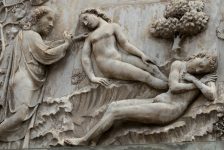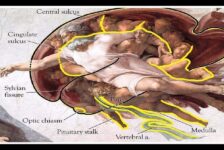There are some verses in the Qur’an that are horribly problematic for Muslims. These are verses that are so clearly wrong that an average 10-year-old could spot the errors. The question is, why don’t grown-up Muslims spot them?
An example is Surah 18. Verse 83 onwards describes Dhul-Qarnayn’s journey to the setting place of the sun. Verse 86 reads:
“Until, when he reached the setting of the sun, he found it set in a spring of murky water: Near it he found a People: We said: “O Zul-qarnain! (thou hast authority,) either to punish them, or to treat them with kindness.”
How Muslims read the Qur’an
When I mentioned this verse to a Muslim friend, he said,
“Reading the verse at face value makes it seem ridiculous; the sun setting in muddy water?!?!? Doesn’t make sense.”
This response made me realize there are two ways to read the Qur’an—how I read it and how Muslims read it. I read the words and let them speak for themselves. If they do not make sense, I conclude they do not make sense.
Muslims start from a different place. They start by ASSUMING the words in the Qur’an are the perfect words of God. So, if they don’t make sense, we need to change their meaning until they do make sense. Why would we ever need to change perfect words so they make sense? I don’t know.
Of course, if you read the Qur’an as a Muslim reads it, you will NEVER find an error no matter how many errors actually exist. This is self-inflicted blindness.
My Muslim friend was right, if you read 18:86 literally as it is written, it doesn’t make sense—it’s ridiculous. But what if the author believed the sun orbited the Earth inside a dome? And what if he believed the sun is a rather small light in the sky and the Earth is flat? Then it would make perfect sense! The sun has to go somewhere at night, and such beliefs were commonplace in the 7th century.
How I read the Qur’an
To study this objectively, we have to make no presumptions about what the author (Mohammed) believed, we have to rely on what is written and only what is written.
I’ve checked 35 English translations of this verse and 27 of them unambiguously agree with the Yusuf Ali translation given above.
Three translations change the meaning by adding the word, “appeared”. An example is the 1980 translation from Muhammad Asad:
“[And he marched westwards] till, when he came to the setting of the sun, it appeared to him that it was setting in a dark, turbid sea; and nearby he found a people [given to every kind of wrongdoing]. We said: “O thou Two-Horned One! Thou mayest either cause [them] to suffer or treat them with kindness!”
We can be SURE these three translations are inaccurate because the original Arabic does not have the word “appeared” or anything with a similar meaning
Five translations also add words, such as “as if” or “seemed to be” but they add these words in square brackets showing that these words are the translators’ own insertions. That is a little more honest than Muhammad Asad but we can still reject them because no such words appear in the original Arabic.
We are left with only one believable meaning for this verse. It really does mean what 27 translations say it means. It means the sun sets IN a pool of water.
Other evidence
Is there anything else in Surah 18 that reveals Mohammed believed the Earth is flat? Yes, there is. It describes Dhul-Qarnayn’s journey west to the setting place of the sun and then east to the sun’s rising place.
With a spherical Earth, there is no “setting-place” of the sun. Wherever you are, you will experience the illusion of the sun setting and rising—you do not have to travel to see these things. Since the sun does not set on the Earth, there is no setting-place—the notion of a setting-place makes no sense.
If the Earth was flat, it would have edges, like a coin. In this case, you could imagine traveling to the western edge to find the place where the sun sets and to the eastern edge to find the place where it rises.
At the end of Dhul-Qarnayn’s westward journey, in verse 86, the Qur’an explicitly mentions the sun’s “setting place”. This is not a bad translation, the Qur’an uses the word “maghriba” which means setting place. This is the Arabic:
مَغْرِبَ
Of course, this is a flat Earth view—a spherical Earth has no setting-place. Then Dhul-Qarnayn turned back and traveled east. Verse 90 tells us what happened next:
“Till, when he reached the rising-place of the sun, he found it rising on a people for whom We had appointed no shelter therefrom.”
This time the word “maṭliʿa” is used which translates directly into “rising-place”. Here is the Arabic:
مَطْلِعَ
The combination of the words “setting place” and “rising place” and the need to undertake a journey to reach those two different places is conclusive—Mohammed believed in a flat Earth and that the sun orbits the Earth.
Is there any other evidence that Mohammed believed the sun sets in water on Earth? Yes, there is. If we turn to Sunan Abi Dawud, a canonical collection of hadith compiled by Imam Abu Dawud Sulayman ibn al-Ash’ath as-Sijistani, at entry 3991 we find a story from Abu Dharr. He says,
“I was sitting behind the Messenger of Allah who was riding a donkey while the sun was setting. He asked: Do you know where this sets? I replied: Allah and his Apostle know best. He said: It sets in a spring of warm water.”
Conclusion
So, let’s summarise. The Qur’an tells us unambiguously that the sun sets in a pool of water, Sunan Abi Dawud relates a story in which the prophet tells a friend that the sun sets in warm water and Surah 18 tells us unambiguously that there is a place on Earth where the sun sets and a different place where it rises.
None of this is Mohammad being crazy. He was simply describing what most 7th century people believed about the way the Earth worked.
If you read the Qur’an carefully, without adding or subtracting words, you come to an inevitable conclusion. The book does not contain the words of an eternal, omniscient god—it contains the words of a 7th-century man and, by today’s standards, a very uneducated man.










